What do you need to consider when thinking about a church wedding? Each denomination and, in fact, every individual church, will have its own set of rules and procedures, but generally you can expect to consider the following series of events:
Choose the Church
Contact the church officials; a vicar, priest or minister. Usually he or she will confirm that there is room on the church schedule for your desired wedding date and that you are able to be married in that particular church (there are some rules about marrying in a church outside of your living location in many cases).
Usually, he or she then invites you to an event to help you prepare for married life.
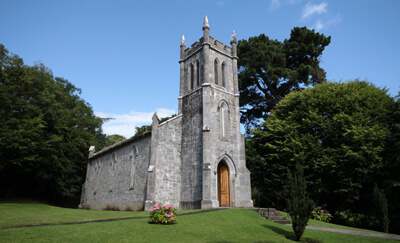
If you are planning a church wedding, it is well worth your time researching all options to find the perfect setting.
This may or may not be a mandatory attendance event, again depending on the denomination, but generally this is set up to provide time for you and your potential spouse to reflect on your choice and ensure that you are ready emotionally to take on this commitment.
Publish the Banns
The Banns are an old tradition that publicly announces your intention to marry and allows anyone to come forth with a reason why your marriage may not lawfully take place (if there is one). The Banns are sometimes published in a local newspaper or simply in the church bulletin. At this time, all members of the church will be praying for you and your intended.
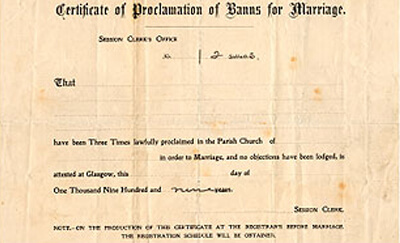
A copy of the Certificate of Proclamation of Banns for Marriage.
Choosing Hymns
One of the first things you will be asked to do when getting married in the church is to choose the hymns you wish played. It is usual to have two to three or as many as four, but you can also choose to have none or to supply your own music in lieu of traditional hymns. The music will have to be cleared by the officiant before it can be used within the church.
Do you have any favorite church hymns?
Choosing Readings
The second thing to consider is which readings you would like as part of your ceremony. Traditionally, Christian couples choose one reading from the Old and one from the New Testaments, the most popular being Song of Solomon and 1 Corinthians. Again, depending on the church, you may choose to forego readings completely or substitute your own text, as long as it is approved in advance by the officiant.
Decorating the Church
Many couples plan their weddings around holidays to take advantage of the beautiful arrangements already in the church on those days and thus save money on their floral budgets. If you don’t wish to plan your special day near a holiday, you will have to think about supplying the church with floral arrangements and decorations for your ceremony. For those with a budget, remember that a simple tulle bow on the ends of the pews can make an elegant statement, and you can also choose arrangements that can be removed after the ceremony and transported to the reception to serve double-duty.
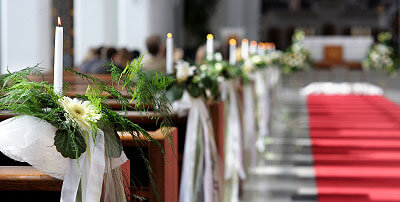
Be sure to ask the church if they allow additional decoration, particularly if you plan on using candles.
You may want to have candles set up near the altar or in specific areas -- these will need to be approved by the church and meet any fire safety standards that might be in place. Some brides also like to have a special runner down the center aisle of the church.
Have you seen some clever or unique wedding decorations for a church?
Schedule the Rehearsal
A day or two before the ceremony is the rehearsal with the bridal party and the officiant. You will have a chance to run through a quick version of the ceremony so all participants are comfortable with their parts.
Beyond the Wedding
Your church, and particularly the officiant of your ceremony, should be there for you as a support throughout your years of marriage. As a symbol of this continuing concern, most churches will pray for you and your spouse on the advent of your first anniversary.
Did You Know?
Under Lord Hardwicke’s Act in 1754, banns of marriage were required in areas of British rule, including Wales, Scotland and Ireland. The resultant banns, or announcement of the impending marriage, were required to be read in church for three Sundays prior to the wedding.
This was thought to prevent people from marrying in haste and also gave any who might object time to learn of the intent of the proposed bride and groom.
Before 1754, it was possible for eloping couples to be married quickly without the publishing of banns by an ordained clergyman, probably for a hefty bribe. After the law, elopers had to leave England and Wales in order to avoid these formalities. Scotland, in particular Gretna Green, the first village over the border from England, was the customary destination for these runaway marriages, but once Scottish law was amended in 1856 to require 21 days residence before a marriage could be legalized, it became less popular.
The Isle of Man enjoyed popularity also, until the Island's legislature passed a similar Act, adding that clergymen who married couples without banns would be pilloried and have their ears cropped.

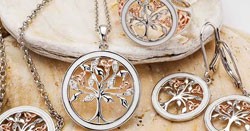

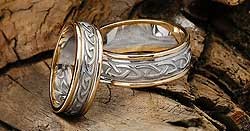
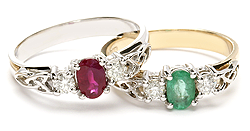

 Emerald Cluster White Gold Ring
Emerald Cluster White Gold Ring  Blue Tanzanite Engagement Ring
Blue Tanzanite Engagement Ring  Emerald Cluster Engagement Ring
Emerald Cluster Engagement Ring 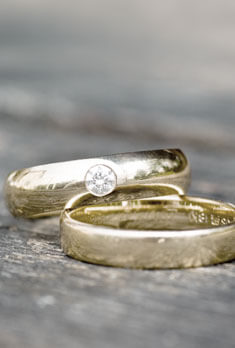

 Women's Trinity Wedding Band
Women's Trinity Wedding Band 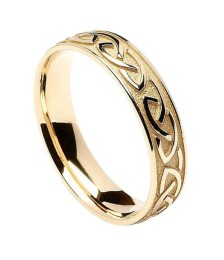 Embossed Celtic Wedding Ring
Embossed Celtic Wedding Ring 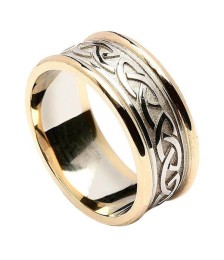 Embossed Celtic Ring with Trim
Embossed Celtic Ring with Trim